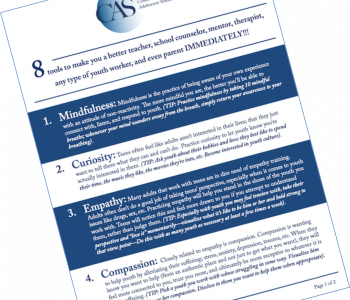

Jordan Smelley, PRSS
Jordan Smelley who is a certified Peer Recovery Support Specialist with Transitional Age Youth Endorsement in Texas uses his lived experience with mental health diagnosis(es) and Intellectual and Developmental disabilities both due to Chung-Jansen Syndrome to help others with mental health diagnoses and/or Intellectual and Developmental Disabilities find the resources and supports they need. Jordan Smelley is also currently the only known case of Chung-Jansen Syndrome in Texas as well as one of roughly 93 known cases worldwide.
3 Tips for Working with Youth with Intellectual and Developmental Disabilities and Trauma
Youth that fall under the category of Intellectual and Developmental Disabilities (IDD) can experience trauma just like their non-disabled peers, contrary to the belief of some. In fact, children with IDD appear to be at an increased risk for physical abuse, physical restraint and seclusion, sexual abuse, and emotional neglect. When trauma occurs with children and families with IDD, it is challenging to effectively address the psychological impact of the event according to a publication on The National Child Traumatic Stress Network’s (NCTSN) website.
I agree with NCTSN because I myself fall under the category of IDD due to Chung-Jansen Syndrome. Chung-Jansen Syndrome is a rare condition caused by a change in the pleckstrin homology domain-interacting protein (PHIP) gene. The most common signs and symptoms, include mild to severe learning problems, behavior problems, and a tendency toward being overweight. I have dealt with trauma due to being bullied for reasons due to Chung-Jansen Syndrome such as my learning disabilities, developmental delay in age appropriate social skills, age appropriate coping skills, having to wear leg braces, among other issues.
My whole purpose for writing this post is to help youth with IDD get the support and help they deserve while reducing the chance of being re-traumatized and/or further traumatized by their providers. Therefore, here are three tips I have found useful both as an individual who meets criteria for IDD and a youth provider working with IDD-impacted youth.
Tip 1: Look for Behaviors, Don’t Rely on Verbal Communication
One reason addressing the impact of a traumatic event for youth with IDD can be challenging is that many youth with IDD have difficulty with verbal communication. Some communicate by their behaviors and this why it’s so important to keep an open mind that behavioral disruptiveness isn’t just “acting out” and that their behavior might be rooted in trauma.
One example to personally illustrate this point comes from the Summer day camp for children with special needs where I interned. One day Cindy (a pseudonym), an 8-year-old nonverbal autistic at the camp, came back from going bowling with the group. I stayed behind because we had campers that couldn’t handle bowling. When Cindy got back, she went to the room that had the TV and DVD player in it. Cindy’s favorite movie was Toy Story and it was on when Cindy walked in. Cindy walked up to the DVD player and started pushing its buttons, which upset the other campers that were watching Toy Story. I picked Cindy up which she was usually okay with. I had done so many times before. When we got to another room Cindy became aggressive which happened right as her grandmother arrived to take her home. I described what had just happened and Cindy’s grandmother explained that the only way she knows how to express that she’s not feeling emotionally safe (because of past trauma) is by taking control of something in her physical environment (which in this case happened to be the DVD Player).
A traumatic adaptation is how an individual protects themselves (often subconsciously) against feelings of fear. It was her adaptation to become aggressive: She felt a loss of control and her behavior was the only way she knew how to communicate that she felt emotionally unsafe. This is why relying on verbal communication with youth diagnosed with IDD can be risky and that we as youth providers should interpret behaviors (especially disruptive behaviors) through a trauma-informed lens.
Tip 2: Don’t Stay Stuck in Your Assessment and Treatment Approach Paradigm
One of the other most important concepts for working with youth with IDD that have experienced trauma is being open to modifying your approach so you can best meet the needs of each youth. Oftentimes therapists and others that support youth with IDD that have been traumatized don’t want to push these youth to tell their story too soon because the therapists and other supporters don’t want to re-traumatize them. However, with youth with IDD, we must let them take the lead so they can feel a sense of autonomy because sometimes youth with IDD are already ready to talk about their trauma but are waiting for an opportunity to do so in a way that is comfortable to them (i.e., not necessarily when we think they should).
Dr. Nora J. Baladerian, a psychologist who has been working with youth with IDD that have experienced trauma for many years references the need to be able to shift and adjust. In one of her presentations she references the case of a 13-year-old girl with Autism who after three weeks of inpatient treatment was referred to her because she showed no improvements and had developed an elective mute defense. The patient was tragically sexually assaulted by her uncle and Dr. Balderian approached her sensitively via a trauma-informed lens.
When Dr. Baladerian mentioned using anatomically correct dolls during the very first visit with the 13-year-old patient and her mom, the patient surprised Dr. Baladerian by asking to see the dolls. Dr. Baladerian described how she protested giving the dolls to her because she thought it was too early in the process (out of fear of re-traumatization), but the patient insisted. Dr. Balderian hesitantly obliged. In turn, they were able to move treatment along at the pace that worked ultimately for the patient.
By using listening, honoring and validating the patient, Dr. Balderian was able to help her shift out of her elective mute defense and further engage treatment. This may not have happened if she relied solely on her expertise and judgment and didn’t take into account the autonomy of her patient.
Tip 3: There’s a High Likelihood for Co-Occurring Mental Health Diagnoses
A final tip to keep in mind is that many youth with IDD also have co-occurring mental health diagnoses. In fact, research has shown that some groups of people with IDD can have up to a 75% co-morbidity rate with other mental health challenges according to the publication: Addressing the Mental Health and Wellness of Individuals with Intellectual Disabilities. I myself have struggled with ADHD, Major Depressive Disorder, and Generalized Anxiety Disorder, along with the developmental disabilities due to Chung-Jansen Syndrome and can personally attest to the difficulties that IDD-impacted youth struggle with in addition to IDD and trauma.
Because of this, it’s extremely important to understand that IDD-impacted youth may exhibit symptoms of other disorders and add layers of complexity to the way you support them. This tip really is an extension of the first above: We must interpret their disruptive behaviors at least through the possibility that it could be rooted in trauma. We then can continuously shift our expectations to meet the unique needs of the youth we are working with, and when appropriate, relinquish autonomy to them to be empowered in the process (tip 2).
The above three tips are a trauma-informed, IDD-informed approach for working with youth. They are basic but from personal and professional experience I can attest to their effectiveness.
In conclusion, a quote from Colleen Horton of the Hogg Foundation for Mental Health summed up why meeting the needs of youth with IDD is so important
We must continue the conversation and continue to build awareness of the long ignored mental health needs of people with IDD. People living with intellectual and other developmental disabilities have the same human right to quality mental health services as everyone.
Resources:
- The National Child Traumatic Stress Network Intellectual and Developmental Disabilities webpage: https://www.nctsn.org/what-is-child-trauma/populations-at-risk/intellectual-and-developmental-disabilities
- At the intersection of Trauma and Disabilities: A new Toolkit for Providers https://www.nctsn.org/resources/intersection-trauma-and-disabilities-new-toolkit-providers
- Policy Recommendations: Addressing the Mental Health and Wellness of Individuals with Intellectual Disabilities (IDD): https://hogg.utexas.edu/project/mental-health-idd
- Trauma and People with Intellectual or Developmental Disabilities: Recognizing Signs of Abuse and Providing Effective Symptom Relief (Presentation). Nora J. Baladerian, PhD. Licensed Psychologist; Director, Disability and Abuse Project; Director, Trauma and Crime Victim Center of West Los Angeles http://dhhr.wv.gov/bhhf/documents/2013%20ibhc%20presentations/day%203%20workshops/healing%20the%20trauma.pdf

